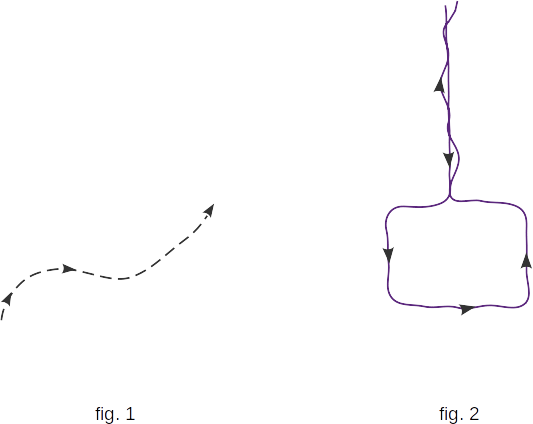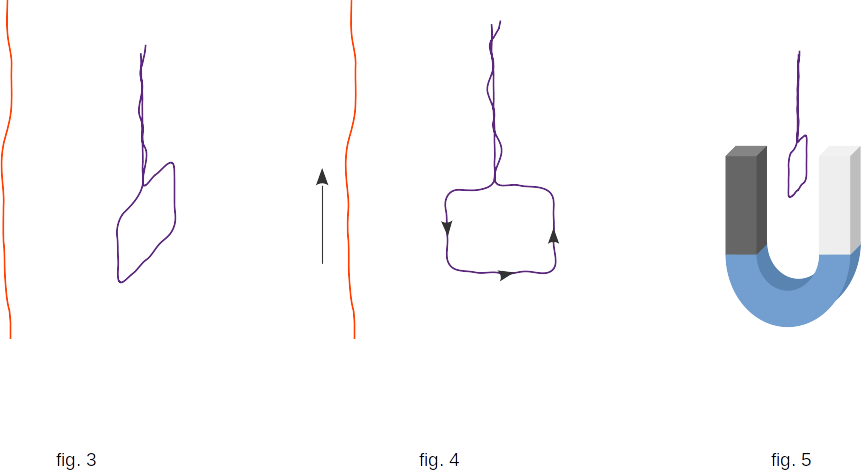From the Magnetic field of currents
121. Magnetic field
So, between moving electric charges, and therefore between conductors with electric current, there are forces of a special nature that are not directly related to the electric field of charges.
Sticking to the theory of proximity, we must assume that the forces are not transmitted through an empty space. Then, to explain the action of conductors with current on each other there is only a method similar to that introduced in the study of electrostatic forces.
Just as an electric field arises in the space surrounding fixed electric charges, a special kind of field called magnetic arises in the space surrounding electric currents.
An electric current in one conductor does not directly affect the electric current in another conductor. It creates a magnetic field around itself, which acts on the electric current in the second conductor. And the magnetic field created by the second electric current acts on the first one.
So how do you answer the question: what is a magnetic field? As in the case of an electric field, this question can only be answered by listing the properties of the field. And these properties can only be determined experimentally.
The main properties of the magnetic field are as follows:
- the magnetic field is generated by an electric current (moving charges);
- the magnetic field is detected by the action on the electric current (moving charges).
The experimental proof of the reality of the magnetic field, as well as the reality of the electric field, is the existence of electromagnetic waves.
A closed circuit and an electric current in the magnetic field.
With what devices can one study the properties of a magnetic field? The most convenient way to study the electric field is to use a small point charge. It is impossible to take a large value charge, as it would cause the redistribution of charges on other conductors and thus distort the field. It is impossible to take also the charged body of the big geometrical sizes as in this case it is possible to find only average value of strength of a field in the space occupied by a charge.
To investigate the magnetic field we would have to take a very small piece of electric current, i.e. a small piece of thin conductor with electric current (fig. 1). However, electric current cannot exist in such a section because any circuit that carries direct electric current is always closed. Therefore, it is impossible to create an element of electric current and, consequently, it is impossible to study the magnetic field with its help.
To study the properties of the magnetic field, you can only take a closed circuit with electric current and measure the total effect of the field on the entire circuit. Meanwhile, the magnetic field is different at different points in space. Therefore, if the circuit is large, its individual parts experience different effects from the magnetic field, and the total action gives only an average field characterization in the large area.
Therefore, it is better to take a closed circuit of small sizes (compared to the distances at which the magnetic field is noticeably changed) to study the magnetic field. For example, it is possible to take a small flat wire frame of any shape (fig. 2). The conductors that supply the electric current should be placed close to each other or twisted together.

Let us make an experience. We will hang a small flat frame vertically on thin, flexible supply wires twisted together. Away from it (at a distance greater than its size), we will place the vertical wire (fig. 3). As long as the electric current flows only in the frame or only in the wire, the frame is in indifferent equilibrium, i.e. it can take any position. If there is electric current both in the frame and in the wire, the frame with current will turn and place so that the wire will be in the plane of the frame (fig. 4). At change of direction of electric current in a wire the frame will turn \(180^0.\)
In this manner, the magnetic field has a directing effect on the small frame with an electric current.

This can also be seen from other experiences. From Physics Book One it is known that the magnetic field can be created with bodies that are able to retain their magnetic state for a long time, i.e. with permanent magnets. Let's take a horseshoe magnet and place a frame hanging on flexible conductors between its poles. If the size of the frame is much smaller than the distance between the poles, then in the presence of electric current the frame will turn so that its plane is perpendicular to the line connecting the poles (fig. 5). At change of an electric current on an opposite direction the frame will turn on \(180^0.\)